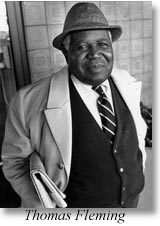

Reflections on Black History
By Thomas C. Fleming
San Francisco History
Index
History by Subject
History by Year
Biographies
The Museum's Homepage
REFLECTIONS ON BLACK HISTORY
Column 4: Boyhood in Harlem, 1916-19
By Thomas C. Fleming
When my father sent for me to join him in Harlem in 1916, he was working as a cook on a coastal freighter between New Haven and New York.
He was glad to have me living with him. But most of the time he was traveling, and I couldn't stay in his apartment alone; I was too young to handle it. So he took me to a woman who kept children of working parents, and he boarded me out. About six black kids were living there, sleeping two in a bed. The woman put me in bed with a kid who had chicken pox, and I got it.
There were a lot of poor people living in Harlem then, most of them working people. Most black men worked in service jobs – cooks, waiters, janitors, bootblacks. Harlem already had the largest black population of any city in the country, but I don't remember a single black bus driver, subway worker, street sweeper or garbage collector. There might have been one or two.
In the three years that I attended public school in Harlem, I never saw a black teacher; they were all white. You did see a few black policemen and firemen, but they were so uncommon that everybody knew who they were.
Most black women worked as domestics – not only in New York, but all over the United States. Most of the time the women were more educated than the men. I think it's because the girls stayed at home longer, and listened to their mothers better. Boys often dropped out of school as low as the 4th or 5th grade, and some didn't go at all.
Harlem then had a lot of poor Italian immigrants, who were still arriving in
large numbers, along with Jews and others from Eastern Europe, and a smattering
of people from the Caribbean islands. As these groups came in, the middle-
Blacks lived primarily on the west side of Harlem, between Lenox Avenue and 7th
Avenue, and the Italians dominated the east side of 5th Avenue, in East Harlem.
Up above us, on Morningside Heights, was a large concentration of Irish.
I think most blacks realized they were segregated, because they were confined to
living in that area. Not by any law, but because most property owners outside of
that area would not rent or sell to them.
For self-
There were two rivers where you could swim in the summertime, the Harlem River
on the east and the Hudson River on the west. The Harlem River was the better
place, but between us and the swimming hole were the Italians. They didn't want
us or the Irish coming through their territory. So we formed an alliance with
the Irish gang. All the kids carried a stick or some other weapon, but not guns.
When we crossed 5th Avenue, here came all the Italian kids, armed the same way
we were. We had to fight our way to the river. Some kids stayed on shore to keep
the Italians back.
We'd throw rocks at each other. They called us nigger, and we would shout, "Oh
you guinea, oh you wop, oh you two-
In the winter of 1917-
It was the whole regiment – about 2000 men, marching in cadence, with a band
playing in front. They had on everything they were issued. The soldiers wore
what they called a campaign hat, with a wide brim. Every one of them had a
knapsack on their back, a topcoat, and a rifle on their shoulder, marching very
proudly.
People were lined up all along the route, and they were all cheering for them.
Kids on the sidewalk were jumping up and down to show off.
The 369th made a great record over there, because the French were short-
©1997 by Thomas C. Fleming. Born in 1907, Fleming is a writer for
the Sun-
Return to the top of the page.
